Mechanical Performance of Built-Up Columns Composed of Four Cold-Formed Square Steel Tubes
Abstract
:1. Introduction
2. Experimental Analysis
2.1. Test Specimens
2.2. Test Setup and Procedure
2.3. Material Properties
3. Test Results
3.1. Failure Mode
3.2. Load-Lateral Displacement Curves
3.3. Load-Strain Curves
4. Numerical Analysis
4.1. Numerical Models
4.2. Validation of Finite Element Model
4.3. Effect of Web Height of Connector
4.4. Effect of Number of Connector
5. Comparisons with AISI-S100-12 Code
6. Conclusions
- (1)
- The experimental results showed that the built-up columns composed of four cold-formed thin-walled steel square tubes failed in flexural buckling.
- (2)
- It has no effect on improving the mechanical performance of built-up columns to change spacing between tubes and to replace the C-shaped connectors with loops formed by steel strip as well as to install a transverse diaphragm. However, the performance can obviously be improved by the change of number of connectors and ratio of web height of connectors to spacing between tubes as well as the installation of connectors at column ends. For the built-up column with length of 3000 mm, it is suggested that the web height/spacing ratio should be 0.4.
- (3)
- The increase in the number of connectors can improve the economic performance of longer columns but reduce the economic performance of shorter columns. In addition, the performance of the built-up column can be improved by mounting connectors at the column ends without changing the spacing between connectors. However, on the premise of the same number of connectors, it has a more obvious effect on improving the mechanical performance to reduce spacing between connectors than to install connectors at column ends.
- (4)
- The current AISI-S100-12 code does not provide a good prediction to the novel built-up columns composed of four cold-formed steel tubes.
Author Contributions
Funding
Acknowledgments
Conflicts of Interest
References
- Fiorino, L.; Macillo, V.; Landolfo, R. Shake table tests of a full-scale two-story sheathing-braced cold-formed steel building. Eng. Struct. 2017, 151, 633–647. [Google Scholar] [CrossRef]
- Fiorino, L.; Terracciano, M.T.; Landolfo, R. Experimental investigation of seismic behaviour of low dissipative CFS strap-braced stud walls. J. Constr. Steel Res. 2016, 127, 92–107. [Google Scholar] [CrossRef]
- Accorti, M.; Baldassino, N.; Zandonini, R.; Scavazza, F.; Rogers, C.A. Response of CFS Sheathed Shear Walls. Structures 2016, 7, 100–112. [Google Scholar] [CrossRef]
- Shamim, I.; Rogers, C.A. Steel sheathed/CFS framed shear walls under dynamic loading: Numerical modelling and calibration. Thin Walled Struct. 2013, 71, 57–71. [Google Scholar] [CrossRef]
- Dabaon, M.; Ellobody, E.; Ramzy, K. Experimental investigation of built-up cold-formed steel section battened columns. Thin Walled Struct. 2015, 92, 137–145. [Google Scholar] [CrossRef]
- Dabaon, M.; Ellobody, E.; Ramzy, K. Nonlinear behaviour of built-up cold-formed steel section battened columns. J. Constr. Steel Res. 2015, 110, 16–28. [Google Scholar] [CrossRef]
- Hosseini Hashemi, B.; Jafari, M.A. Evaluation of Ayrton-Perry formula to predict the compressive strength of batten columns. J. Constr. Steel Res. 2012, 68, 89–96. [Google Scholar] [CrossRef]
- Stone, T.A.; LaBoube, R.A. Behavior of cold-formed steel built-up I-sections. Thin Walled Struct. 2005, 43, 1805–1817. [Google Scholar] [CrossRef]
- Lu, Y.; Zhou, T.; Li, W.; Wu, H. Experimental investigation and a novel direct strength method for cold-formed built-up I-section columns. Thin Walled Struct. 2017, 112, 125–139. [Google Scholar] [CrossRef]
- Anbarasu, M.; Kanagarasu, K.; Sukumar, S. Investigation on the behaviour and strength of cold-formed steel web stiffened built-up battened columns. Mater. Struct. 2015, 48, 4029–4038. [Google Scholar] [CrossRef]
- Maia, W.F.; Vieira, L.C.M., Jr.; Schafer, B.W.; Malite, M. Experimental and numerical investigation of cold-formed steel double angle members under compression. J. Constr. Steel Res. 2016, 121, 398–412. [Google Scholar] [CrossRef]
- El Aghoury, M.A.; Salem, A.H.; Hanna, M.T.; Amoush, E.A. Strength of cold formed battened columns subjected to eccentric axial compressive force. J. Constr. Steel Res. 2015, 113, 58–70. [Google Scholar] [CrossRef]
- El Aghoury, M.A.; Salem, A.H.; Hanna, M.T.; Amoush, E.A. Ultimate capacity of battened columns composed of four equal slender angles. Thin Walled Struct. 2013, 63, 175–185. [Google Scholar] [CrossRef]
- El Aghoury, M.A.; Salem, A.H.; Hanna, M.T.; Amoush, E.A. Experimental investigation for the behaviour of battened beam-columns composed of four equal slender angles. Thin Walled Struct. 2010, 48, 669–683. [Google Scholar] [CrossRef]
- Reyes, W.; Guzmán, A. Evaluation of the slenderness ratio in built-up cold-formed box sections. J. Constr. Steel Res. 2011, 67, 929–935. [Google Scholar] [CrossRef]
- Whittle, J.; Ramseyer, C. Buckling capacities of axially loaded, cold-formed, built-up C-channels. Thin Walled Struct. 2009, 47, 190–201. [Google Scholar] [CrossRef]
- Liu, X.; Zhou, T. Research on axial compression behavior of cold-formed triple-lambs built-up open T-section columns. J. Constr. Steel Res. 2017, 134, 102–113. [Google Scholar] [CrossRef]
- Aoki, T.; Ji, B. Experimental Study on Buckling Strength of Tri-Tube Steel Members. In Proceedings of the 3th International Conference on Coupled Instabilities in Metal Structures, Lisbon, Portual, 21–23 September 2000; pp. 283–290. [Google Scholar]
- Heidarpour, A.; Cevro, S.; Song, Q.; Zhao, X. Behaviour of stub columns utilising mild-steel plates and VHS tubes under fire. J. Constr. Steel Res. 2014, 95, 220–229. [Google Scholar] [CrossRef]
- Heidarpour, A.; Cevro, S.; Song, Q.; Zhao, X. Behaviour of innovative stub columns utilising mild-steel plates and stainless steel tubes at ambient and elevated temperatures. Eng. Struct. 2013, 57, 416–427. [Google Scholar] [CrossRef]
- Javidan, F.; Heidarpour, A.; Zhao, X.; Minkkinen, J. Performance of innovative fabricated long hollow columns under axial compression. J. Constr. Steel Res. 2015, 106, 99–109. [Google Scholar] [CrossRef]
- Kesawan, S.; Mahendran, M. Fire design rules for LSF walls made of hollow flange channel sections. Thin Walled Struct. 2016, 107, 300–314. [Google Scholar] [CrossRef]
- Kesawan, S.; Mahendran, M. Predicting the performance of LSF walls made of hollow flange channel sections in fire. Thin Walled Struct. 2016, 98, 111–126. [Google Scholar] [CrossRef]
- Kesawan, S.; Mahendran, M. Thermal performance of load-bearing walls made of cold-formed hollow flange channel sections in fire. Fire Mater. 2015, 40, 704–730. [Google Scholar] [CrossRef]
- Kesawan, S.; Mahendran, M.; Dias, Y.; Zhao, W. Compression tests of built-up cold-formed steel hollow flange sections. Thin Walled Struct. 2017, 116, 180–193. [Google Scholar] [CrossRef]
- Guo, Y.; Wang, J. Instability behavior and application of prismatic multi-tube latticed steel column. J. Constr. Steel Res. 2009, 65, 12–22. [Google Scholar] [CrossRef]
- Guo, Y.; Zhang, B.; Zhao, S.; Dou, C.; Pi, Y. Ultimate Resistance Design of Shuttle-Shaped Steel Tubular Latticed Columns. J. Struct. Eng. 2014, 140, 4014076. [Google Scholar] [CrossRef]
- Technical code of cold-formed thin-wall steel structures. In GB 50018-2002; China Planning Press: Beijing, China, 2002.
- Metallic materials—Tensile testing at ambient temperature. In GB/T 228.1-2010; Standards Press of China: Beijing, China, 2010.
- Bertocci, L.; Comparini, D.; Lavacchini, G.; Orlando, M.; Salvatori, L.; Spinelli, P. Experimental, numerical, and regulatory P-Mx-My domains for cold-formed perforated steel uprights of pallet-racks. Thin Walled Struct. 2017, 119, 151–165. [Google Scholar] [CrossRef]
- Szymczak, C.; Kujawa, M. Buckling of thin-walled columns accounting for initial geometrical imperfections. Int. J. Nonlin. Mech. 2017, 95, 1–9. [Google Scholar] [CrossRef]
- Orlando, M.; Lavacchini, G.; Ortolani, B.; Spinelli, P. Experimental capacity of perforated cold-formed steel open sections under compression and bending. Steel Compos. Struct. 2017, 24, 201–211. [Google Scholar]
- Young, B.; Ellobody, E. Design of cold-formed steel unequal angle compression members. Thin Walled Struct. 2007, 45, 330–338. [Google Scholar] [CrossRef]
- Ellobody, E.; Young, B. Behavior of Cold-Formed Steel Plain Angle Columns. J. Struct. Eng. 2005, 131, 457–466. [Google Scholar] [CrossRef]
- Ye, J.; Feng, R.Q.; Chen, W.; Liu, W. Behavior of cold-formed steel wall stud with sheathing subjected to compression. J. Constr. Steel Res. 2016, 116, 79–91. [Google Scholar] [CrossRef]
- North American specification for the design of cold-formed steel structural members. In AISI-S100-12; American Iron and Steel Institute: Washington, DC, USA, 2012.



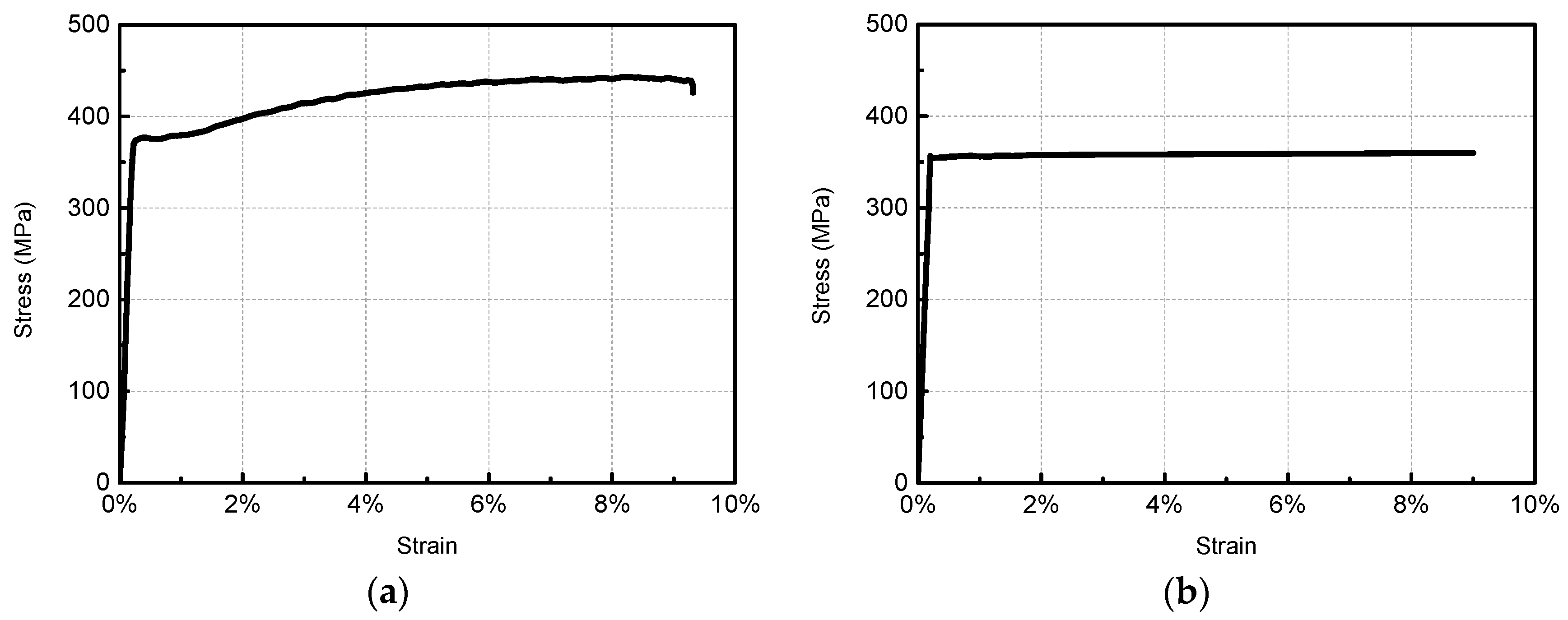

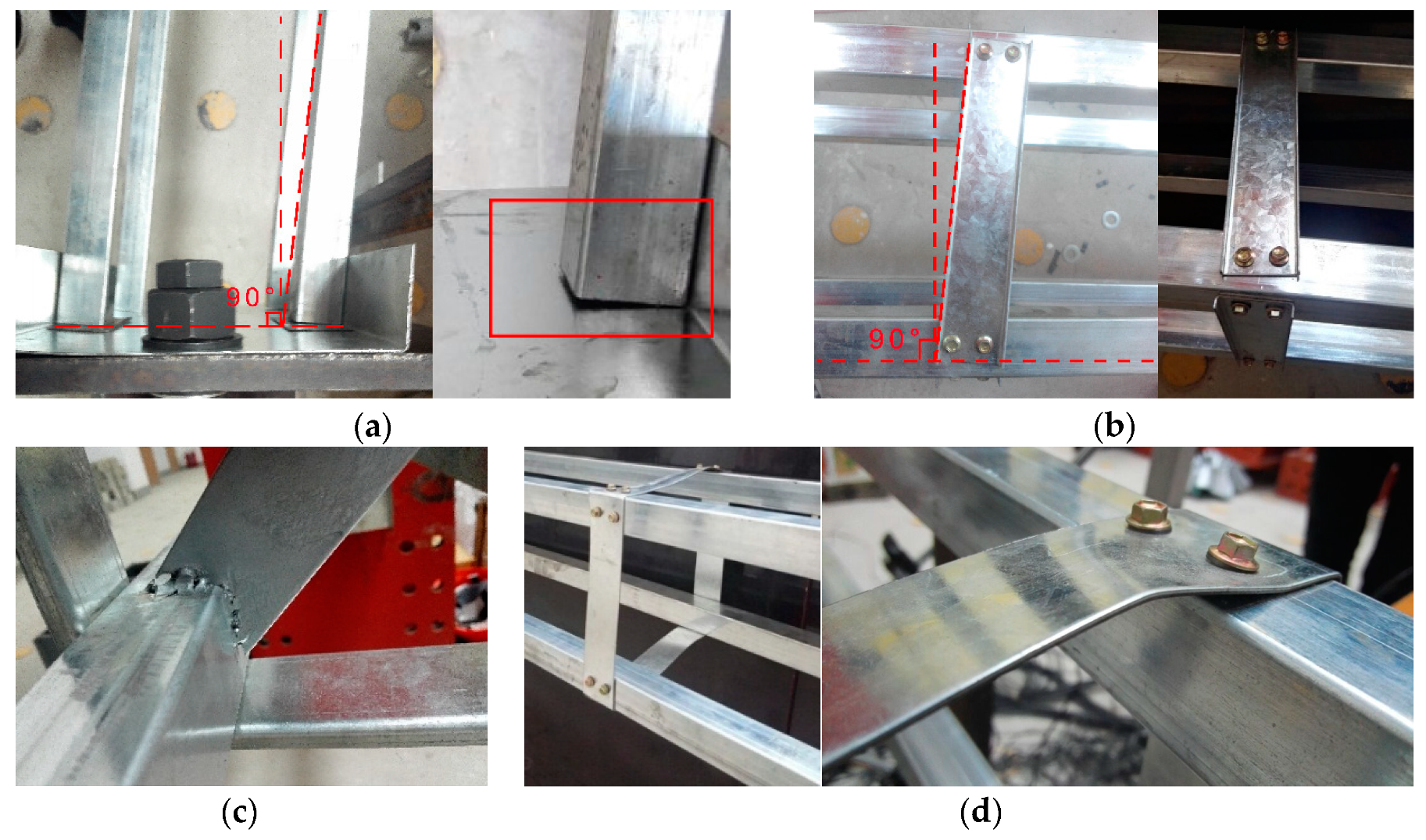
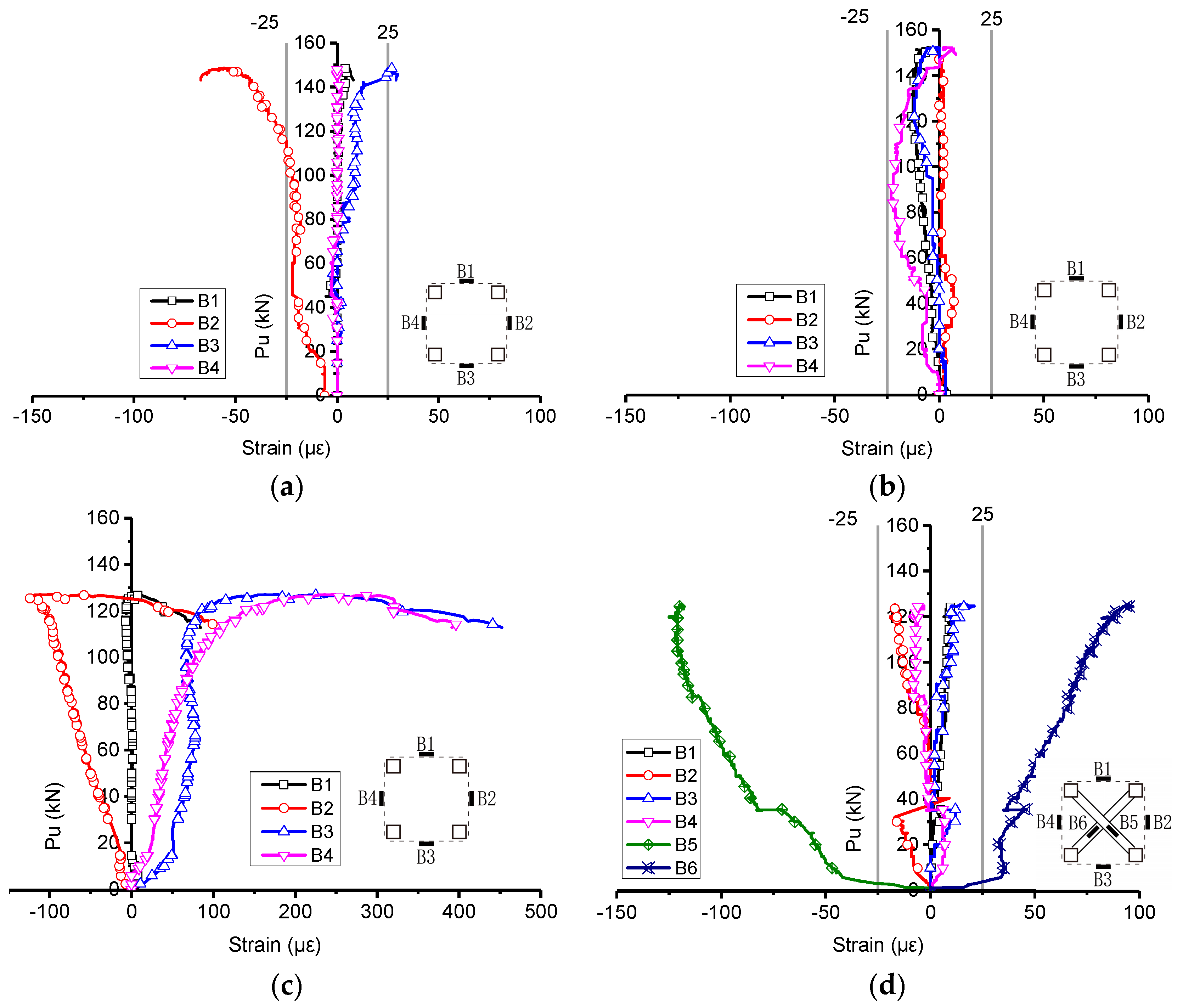
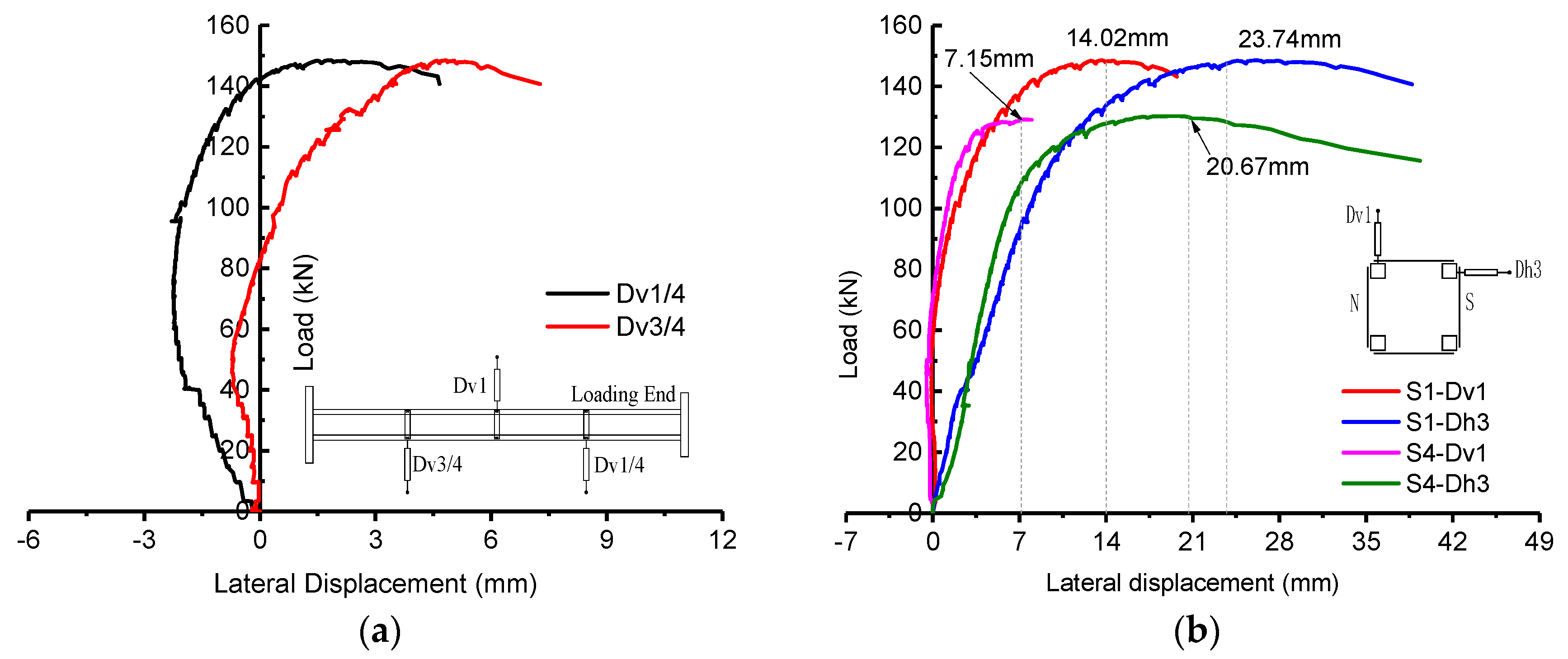
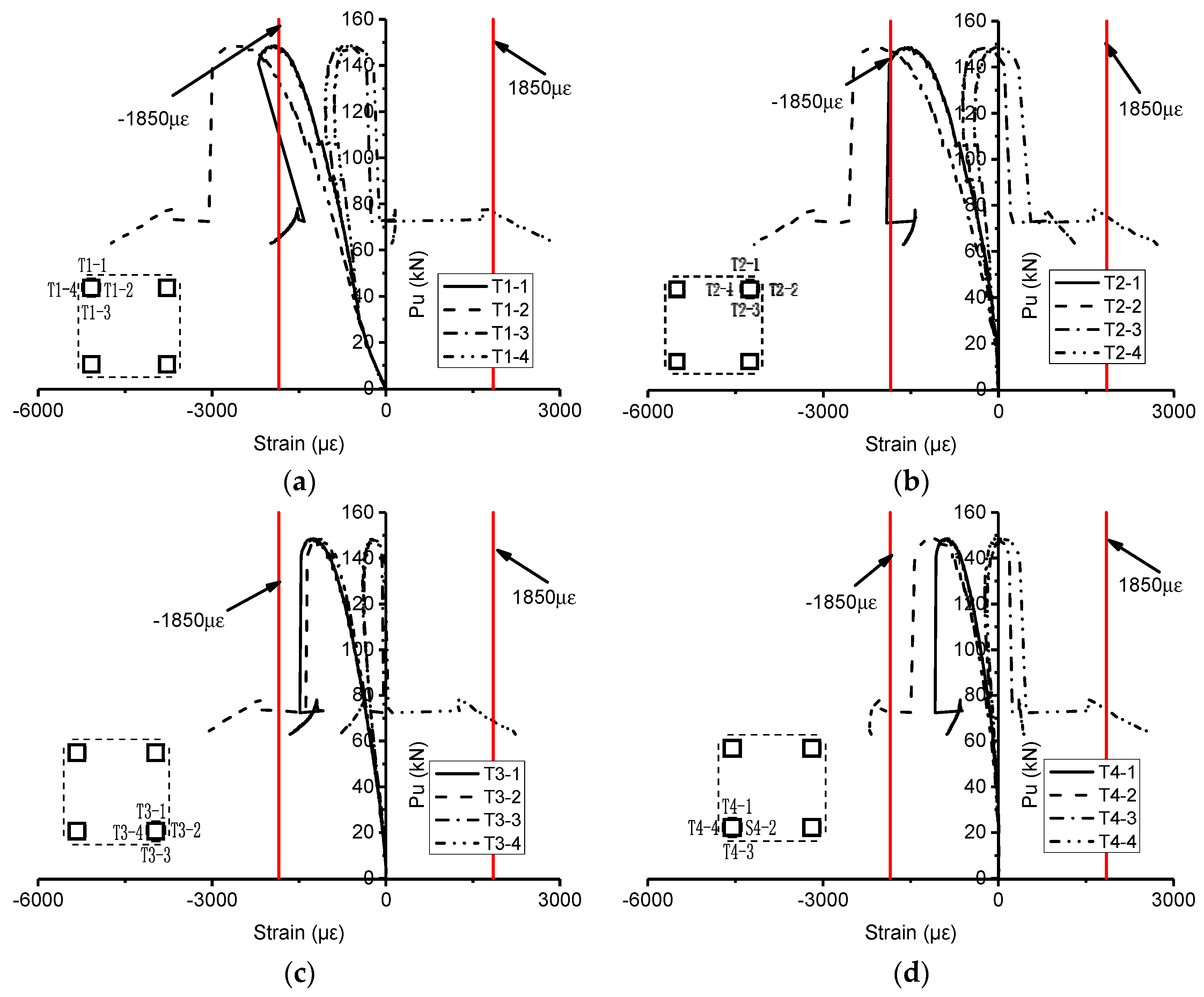
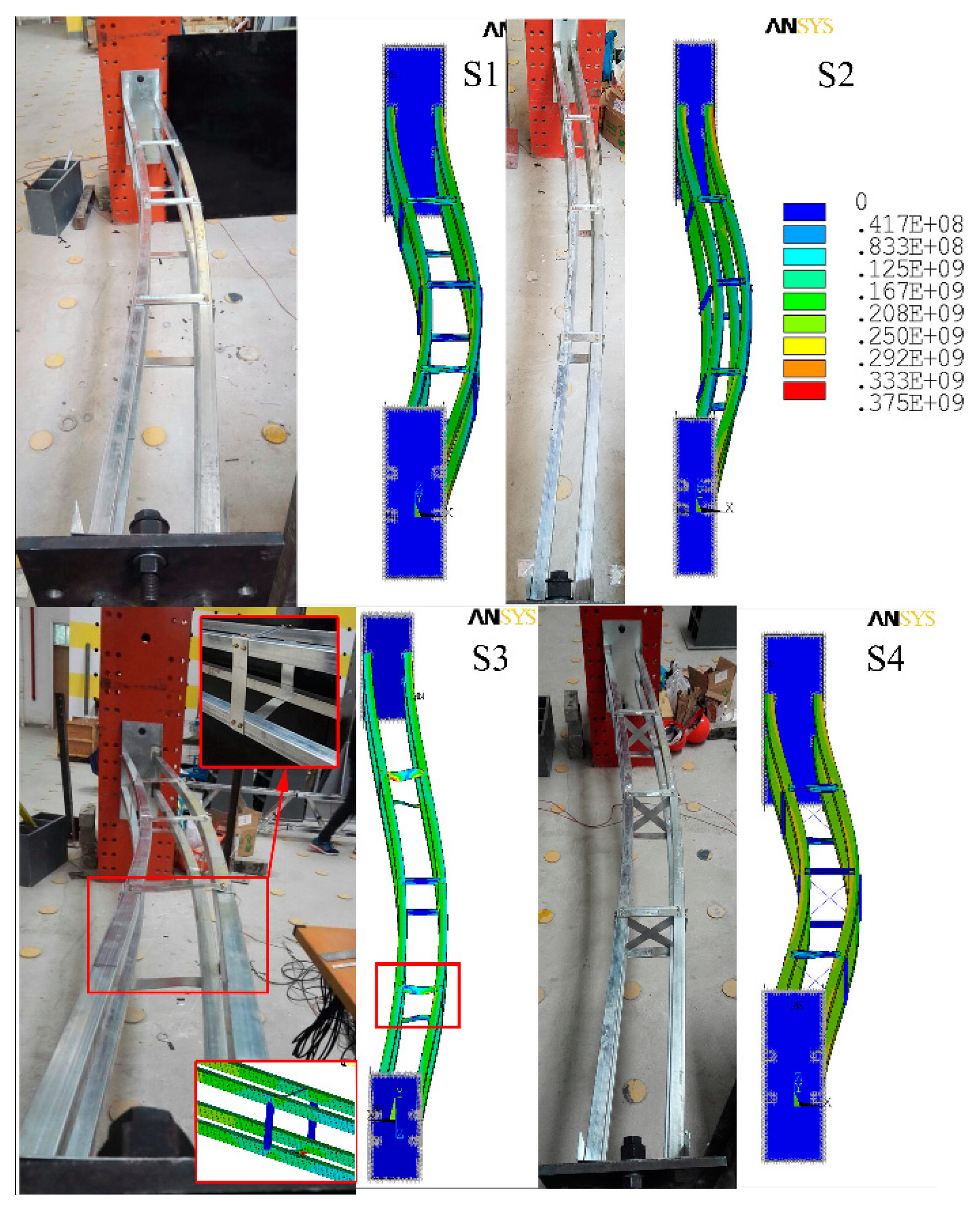
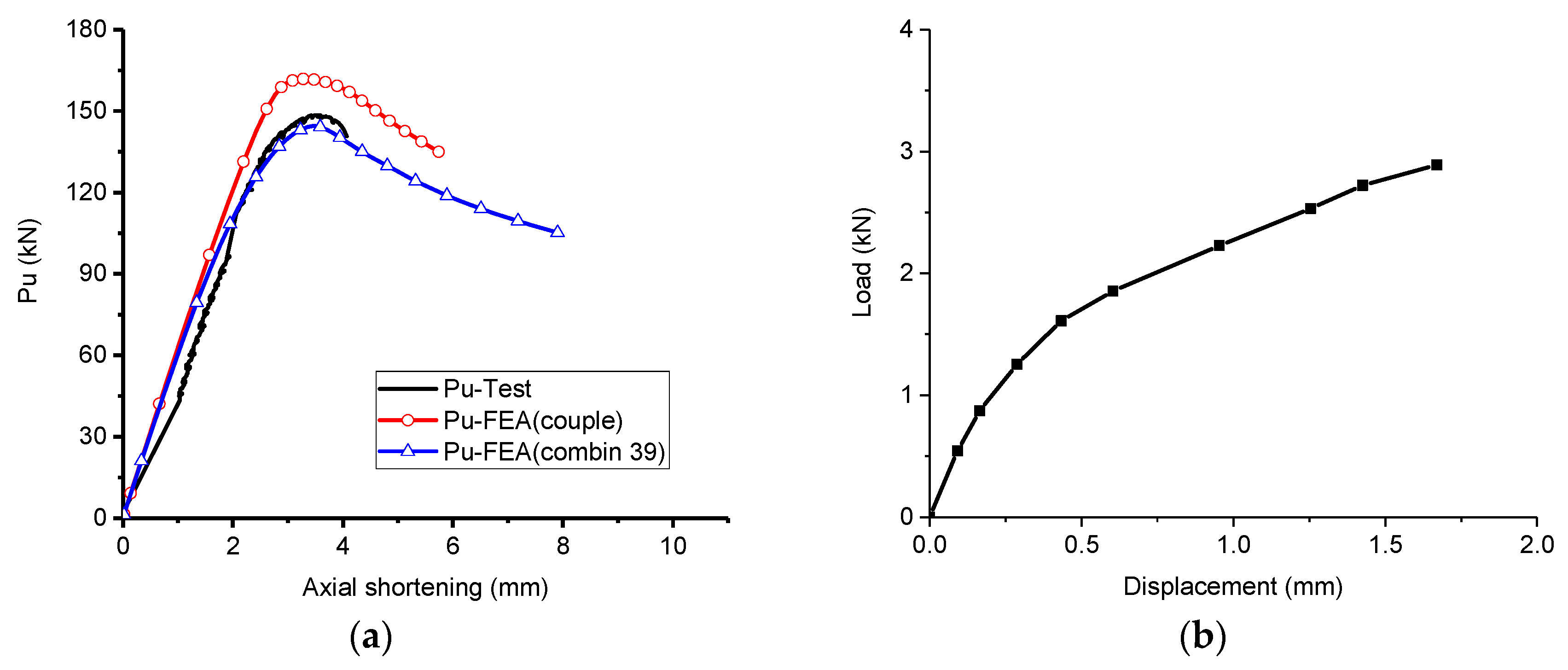

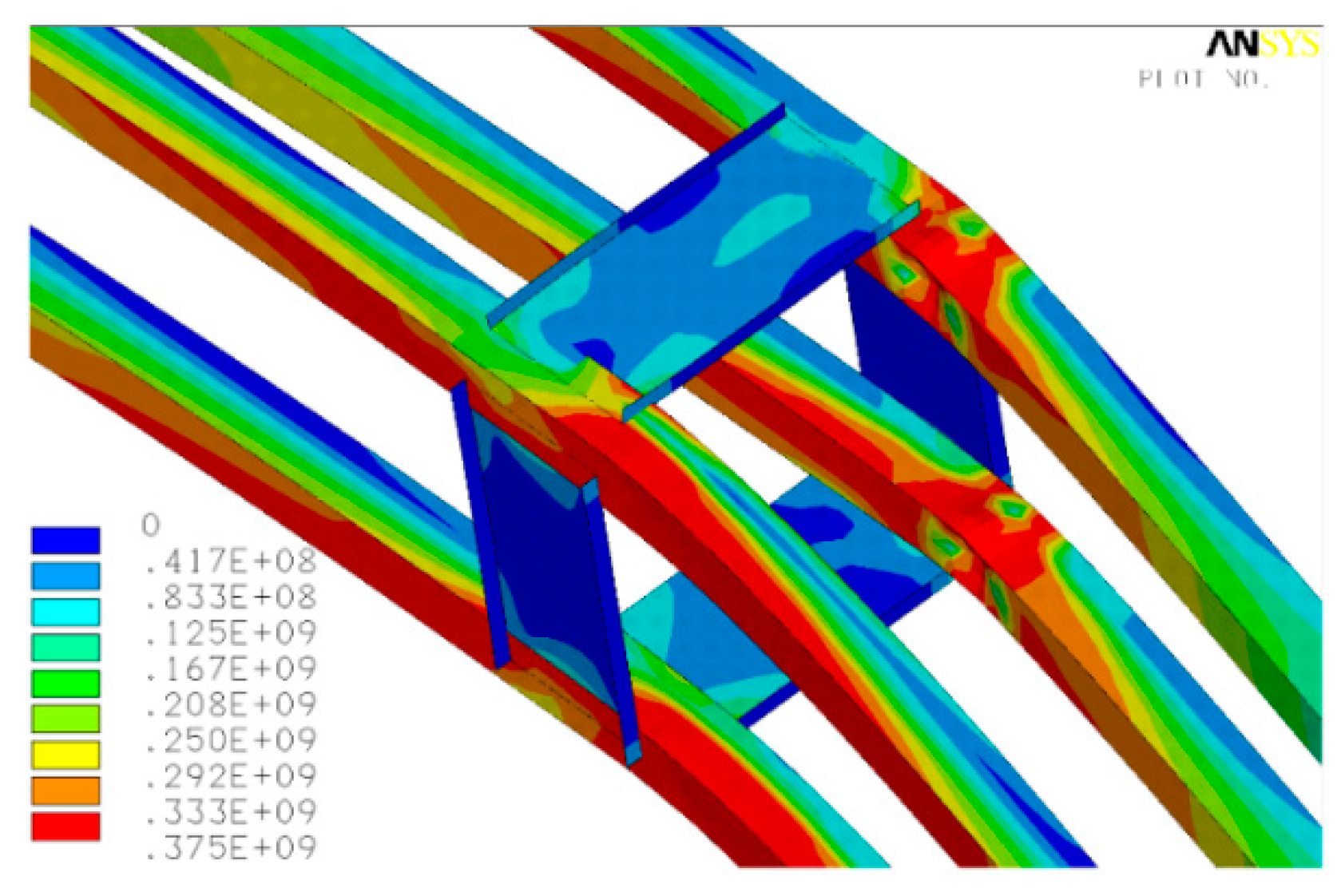


| No. | Specimen | Length (mm) | S 1 (mm) | W 2 (mm) | Section Form of Batten Plate | Transverse Diaphragm |
|---|---|---|---|---|---|---|
| S1 | L3000-S700-W200 | 3000 | 700 | 200 | channel | no |
| S2 | L3000-S700-W110 | 3000 | 700 | 110 | channel | no |
| S3 | L3000-S700-W200-Strip | 3000 | 700 | 200 | strip | no |
| S4 | L3000-S700-W200-X | 3000 | 700 | 200 | channel | yes |
| Specimen | Yield Stress σy (MPa) | Ultimate Stress σu (MPa) | σu/σy | Young’s Odulus E (GPa) | |
|---|---|---|---|---|---|
| tubes | 1 | 378 | 450 | 1.191 | 193 |
| 2 | 372 | 447 | 1.202 | 203 | |
| 3 | 375 | 451 | 1.204 | 216 | |
| Average values | 375 | 450 | 1.199 | 204 | |
| connectors and tracks | 1 | 352 | 360 | 1.022 | 180 |
| 2 | 343 | 349 | 1.017 | 165 | |
| 3 | 355 | 363 | 1.023 | 174 | |
| Average values | 350 | 357 | 1.021 | 173 | |
| No. | Specimen | P-Test kN | P-FEA kN | P-FE/P-Test |
|---|---|---|---|---|
| S1 | L3000-S700-W200 | 148.55 | 161.01 | 1.08 |
| S2 | L3000-S700-W110 | 152.48 | 162.94 | 1.07 |
| S3 | L3000-S700-W200-Strip | 125.00 | 132.90 | 1.06 |
| S4 | L3000-S700-W200-X | 130.25 | 132.52 | 1.02 |
| No. | Specimen | L (mm) | N | S (mm) | P-FEA (kN) | STW Ratio | Pu-AISI (kN) | P-FEA/Pu-AISI |
|---|---|---|---|---|---|---|---|---|
| 1 | L3000S400-7 | 3000 | 7 | 400 | 202.0 | 773 | 303.3 | 0.67 |
| 2 | L3000S500-5 | 3000 | 5 | 500 | 190.3 | 765 | 295.5 | 0.64 |
| 3 | L3000S700-5 (end) | 3000 | 5 | 700 | 183.9 | 739 | 275.8 | 0.67 |
| 4 | L3000S600-4 | 3000 | 4 | 600 | 179.1 | 738 | 286.3 | 0.63 |
| 5 | L3000S700-3 L3000-S700-W200 L3000-S700-W110 L3000-S700-W200-Strip L3000-S700-W200-X | 3000 | 3 | 700 | 161.0 (148.6) (152.5) (132.9) (132.5) | 682 (629) (667) (543) (546) | 275.8 (275.8) (263.7) (275.8) (275.8) | 0.58 (0.54) (0.58) (0.48) (0.48) |
| 6 | L3000S1000-2 | 3000 | 2 | 1000 | 152.9 | 665 | 238.2 | 0.64 |
| 7 | L3000S1500-1 | 3000 | 1 | 1500 | 139.5 | 623 | 166.3 | 0.84 |
| 8 | L3000S3000-0 | 3000 | 0 | 3000 | 131.1 | 603 | 45.2 | 2.90 |
| 9 | L2400S400-5 | 2400 | 5 | 400 | 256.0 | 1248 | 303.7 | 0.84 |
| 10 | L2400S500-4 | 2400 | 4 | 500 | 242.4 | 1218 | 295.9 | 0.82 |
| 11 | L2400S600-3 | 2400 | 3 | 600 | 233.6 | 1212 | 286.7 | 0.81 |
| 12 | L2400S700-2 | 2400 | 2 | 700 | 206.4 | 1106 | 276.2 | 0.75 |
| 13 | L2400S1200-1 | 2400 | 1 | 1200 | 195.5 | 1084 | 210.2 | 0.93 |
| 14 | L2400S2400-0 | 2400 | 0 | 2400 | 196.4 | 1128 | 70.6 | 2.78 |
| 15 | L1800S400-4 | 1800 | 4 | 400 | 292.0 | 1879 | 304.0 | 0.96 |
| 16 | L1800S500-3 | 1800 | 3 | 500 | 302.1 | 2024 | 296.3 | 1.02 |
| 17 | L1800S600-2 | 1800 | 2 | 600 | 276.2 | 1932 | 287.0 | 0.96 |
| 18 | L1800S900-1 | 1800 | 1 | 900 | 262.9 | 1922 | 252.2 | 1.04 |
| 19 | L1800S1800-0 | 1800 | 0 | 1800 | 269.6 | 2065 | 125.5 | 2.15 |
| 20 | L1200S300-3 | 1200 | 3 | 300 | 335.7 | 3176 | 310.4 | 1.08 |
| 21 | L1200S400-2 | 1200 | 2 | 400 | 339.7 | 3415 | 304.3 | 1.12 |
| 22 | L1200S600-1 | 1200 | 1 | 600 | 326.2 | 3498 | 287.3 | 1.14 |
| 23 | L1200S1200-0 | 1200 | 0 | 1200 | 322.5 | 3705 | 210.6 | 1.53 |
| 24 | L600S300-1 | 600 | 1 | 300 | 336.6 | 6768 | 310.6 | 1.08 |
| 25 | L600S600-0 | 600 | 0 | 600 | 340.9 | 7832 | 287.4 | 1.19 |
| Mean | 1.11 | |||||||
| COV | 0.56 |
© 2019 by the authors. Licensee MDPI, Basel, Switzerland. This article is an open access article distributed under the terms and conditions of the Creative Commons Attribution (CC BY) license (http://creativecommons.org/licenses/by/4.0/).
Share and Cite
Chen, X.; Xia, J.; Xu, B.; Ma, R. Mechanical Performance of Built-Up Columns Composed of Four Cold-Formed Square Steel Tubes. Appl. Sci. 2019, 9, 1204. https://doi.org/10.3390/app9061204
Chen X, Xia J, Xu B, Ma R. Mechanical Performance of Built-Up Columns Composed of Four Cold-Formed Square Steel Tubes. Applied Sciences. 2019; 9(6):1204. https://doi.org/10.3390/app9061204
Chicago/Turabian StyleChen, Xiaomiao, Junwu Xia, Bo Xu, and Renwei Ma. 2019. "Mechanical Performance of Built-Up Columns Composed of Four Cold-Formed Square Steel Tubes" Applied Sciences 9, no. 6: 1204. https://doi.org/10.3390/app9061204





